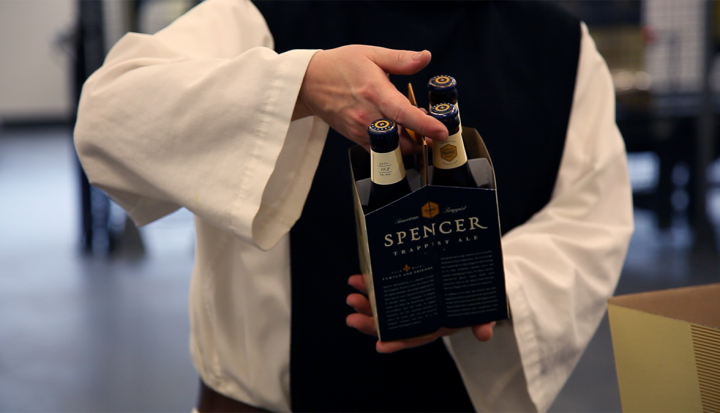At 10:00 a.m., Fr. Isaac Keeley pauses to pray. But this Trappist monk isn’t shuffling into a choir stall flanked by icons for his mid-morning ritual. The space where he and his brother monks gather doesn’t reek of incense, either. Instead there is another distinct smell wafting around: hops. Yes, a few of the monks of Spencer Abbey pray the “little hours” together in a brewery—their own brewery, no less.
“I don’t know what Thomas Merton would say about this!” Keeley laughs.
Saint Joseph’s Abbey, tucked among the forests and hills of Spencer, Massachusetts, is home to 54 monks who live a communal life guided by the Rule of Saint Benedict. It also houses the first Trappist brewery in the United States.
A small group of monks journeyed from France to found the religious community in 1825, but it wasn’t until 2013 that the monks got into the habit of brewing beer. The community was discerning future financial needs, as their jam and jelly sales were not bringing in enough profit.
“We looked for some work with a strong manual labor component, since that is important to monastic life, and that would also produce enough revenue to be sustaining for the monastery and our charitable outreach,” says Keely, who serves as the brewery’s founding director.
The community spent more than five years discussing the project before it was put to a vote. During this time, a group of monks traveled to six Trappist breweries in Belgium, assessing facilities and learning about the science of brewing beer.
Monks have a long tradition of brewing beer. The oldest known drawings of a modern brewery were found in St. Gall Monastery in Switzerland and date back to 820 CE. Keeley explains the brewing process is compatible with the rhythm of monastic life.
“The process of converting barley grain to sugars and getting the liquid ready to turn over to the yeast is actually a pretty quiet, contemplative process,” says Keeley.
Five monks work in the brewery daily, doing everything from quality control to warehouse maintenance and packaging. They also employ lay brewers who trained at Belgian Trappist breweries. Keeley says Spencer Brewery’s first beer, the golden Spencer Trappist Ale, is also its most popular.
“Before we got into brewing, many of our monks would have said they are wine drinkers, so we wanted to make our first beer particularly accessible to people who like wine,” Keeley says. “This refreshing ale has fruity flavors and aromas and spice nodes.”
The brewery concocts two additional “Trappist Classics”: a darker Holiday Ale and a “robust” Trappists Monks’ Reserve Ale that boasts a high alcohol content of 10.2 percent. They now have four American Trappist craft beers on tap as well.
Currently, five states carry Spencer brews: Massachusetts, New Hampshire, Connecticut, Ohio, and Michigan. Approximately 40 percent of their product is exported to Europe.
The monks are committed to sustainable brewing production. They work with the U.S. Department of Agriculture and local farmers to study best practices for growing ingredients like barley and composting spent grain. The brewery is powered by a high efficiency energy management system and includes a water recycling process, among other green initiatives. Keeley says the monastic vow of stability is at the heart of the brewery.
“It’s interesting to us that sustainability has become a major western cultural value, since it harmonizes with something that’s so traditional for monastics,” Keeley explains. “We are on this land for the long run. There’s nothing throw-away about where we live. It’s an ancient monastic value that resonates easily with contemporary environmental sensitivities and awareness of the need to live in such a way that we can hand on what we’ve received to the next generations.”
From barrel to bottle, the fascination with beer-brewing monks and their brewery continues to mount. Spencer Brewery was voted “#1 Best New Brewery” by the Huffington Post and Fox News. Media from around the world call the Abbey for interviews.
For monks used to a humble, quiet life, this newfound fame took some adjustment. The monastery hired a lay communication specialist to train the monks in media relations. Today Keeley sees the brewery as a platform for people to learn more about monastic life.
“The beer culture in the west has certainly grown, and in my opinion, so has a hunger for God,” says Keeley. “Beer acts as a safe connection for people to inquire about religious people or religious institutions like monasteries. We’ve seen quite an uptick in interest in our monastery since we started brewing beer.”
To be a certified Trappist brewery, the brewery must be located inside the monastic enclosure. This means most of the time, Spencer Brewery is accessible only to monks and select employees. However, the community invites the general public into the brewery once a year for an open house. It’s an “all monks on deck” day to help with hospitality. The first year, some 2,500 guests showed up. Last year, upwards of 5,000 people made the visit.
“People are so curious to discover, ‘wow! A real community lives back here!’” laughs Keeley. “It’s a chance to have more casual interactions with monks. People read articles about us and want to keep watch with what’s going on.”
It is safe to say the monks of Saint Joseph’s Abbey found a recipe for success with Spencer Brewery. Business is booming, the monastic mission is spreading—and the monks themselves are enjoying the fruits of their labors.
“Before starting the brewery, we would have consumed alcohol, typically wine, just on major feast days,” explains Keeley. “Now we have beer every Sunday night and on feast days! Some brothers say we should have it more often, but the Abbot says we’ve upped it from 10 times to 52 times a year, so what’s the problem?! It’s a big jump!”













Add comment